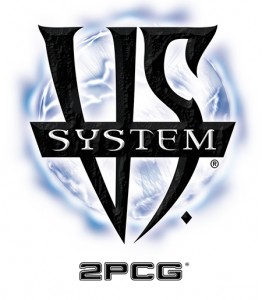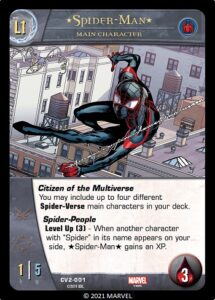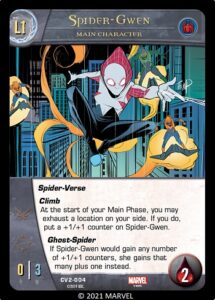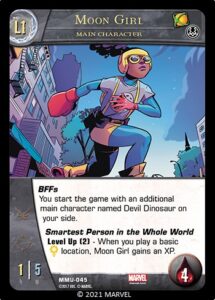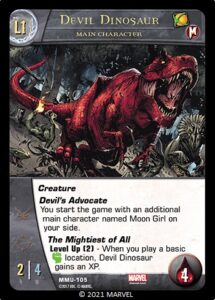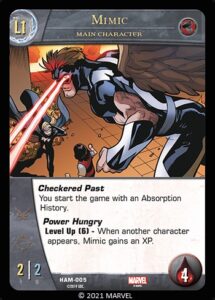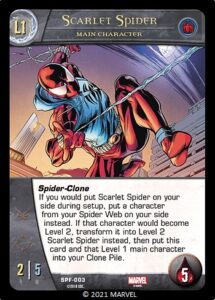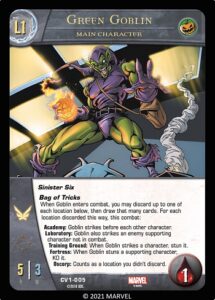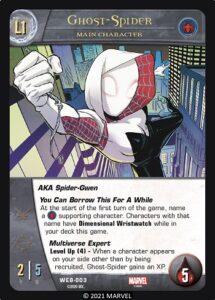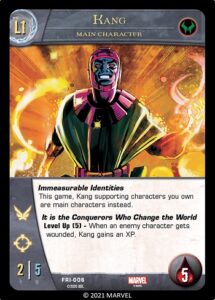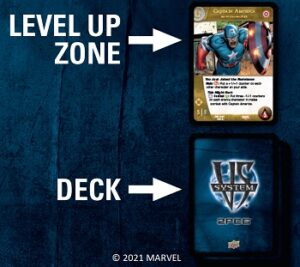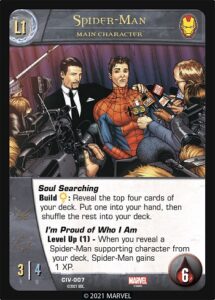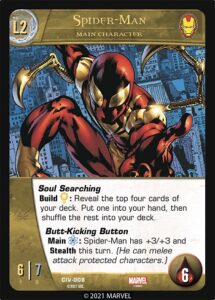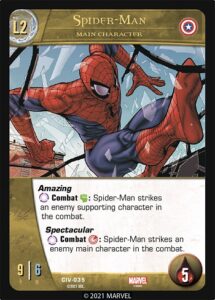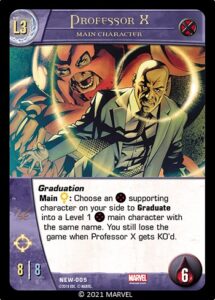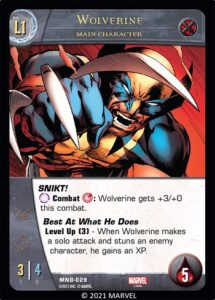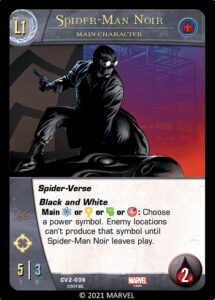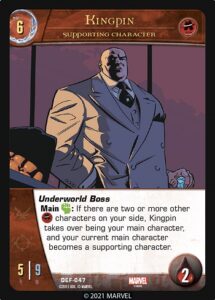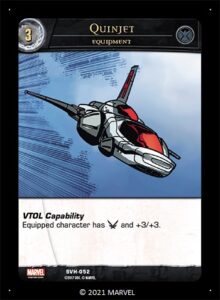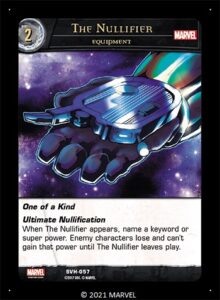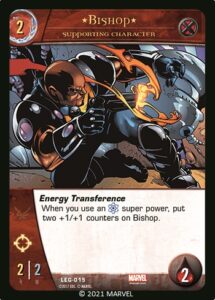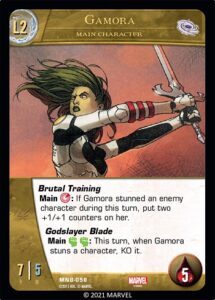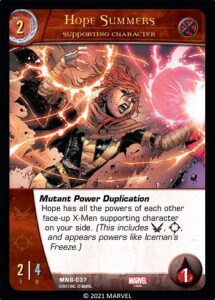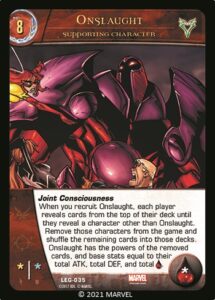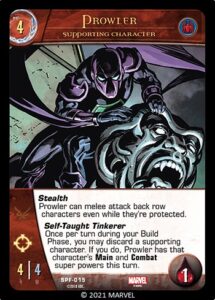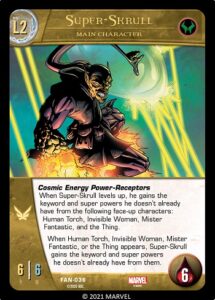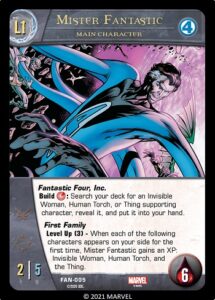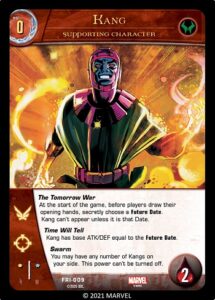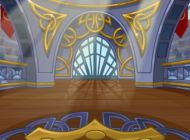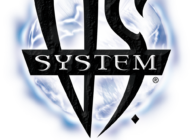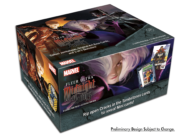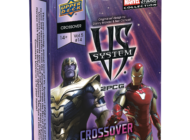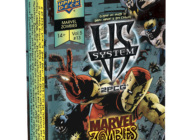Hello Vs. System® 2PCG® players!
We have several updates for you today. Many of these are just tightening up or clarifying existing rules which won’t affect the way you’ve already been playing the game. However, some are actual rules changes that will affect how some cards play. We’ll call these out as they come up.
We’re going to go over the following aspects of the game:
- Setup Procedure
- Defining when each part of setup occurs and what each step includes.
- Examples of card effects that happen during setup.
- The Level Up Zone
- Defining which cards start the game here (and which start in out-of-game piles).
- Adding a rule that you can only access your own Level Up Zone and only with the printed power of a card you own.
- Out-of-Game Piles
- Defining the rules of Out-of-Game piles.
- Listing cards that now use Out-of-Game piles. (These do not change how the cards function).
- Link to a spreadsheet with a complete list of piles.
- Functional change to Invention Pile — content is now optional.
- Leveling Up Characters
- Reviewing criteria that determines which characters can level up into which characters.
- Adding a new criterion that a character must share a team affiliation with a character it levels up into (unless otherwise stated on the card).
- Transforming Characters
- Reviewing rules of transformations including where the transforming card goes
- Main Character Cards Entering the KO Pile
- Adding a rule that if a main character enters the KO pile from anywhere it is removed from the game.
- Equipment Powers
- Changing the rules so that an equipment’s powers are no longer granted to the equipped character. (This leads to some functional changes.)
- Card Names and Intellectual Properties
- Adding a rule that card names do not cross Intellectual Properties for the purposes of Uniqueness and Power-Ups.
- Functional Updates to Specific Cards
- Listing card updates that will alter their functionality.
- “Under the Hood” Updates to Specific Cards
- Listing card updates that will not alter their functionality.
We are also hard at work compiling all these updates into one convenient place. All these changes will soon be reflected in the Compiled Rulebook found here: upperdeck.com/op/, but are effective immediately for game play.
Let’s dive in!
Setup Procedure
We’ve tightened up the rules for how setup works. It still works the way it always did, but now it’s easier to see when certain “during setup” or “at start of game” effects occur. Here is the updated process (changes are underlined):
- Step 1: Decks and Counters
Each player will have a deck that has one Main Character and exactly 60 game cards. (This does not include any cards that start in your Level Up Zone or out-of-game piles, or any additional starting main characters an effect may give a player.)
Put the wound, vitality, XP, +1/+1, and -1/-1 counters nearby.
- Step 2: Reveal Starting Main Characters
Players reveal their starting Main Character simultaneously. Then they announce any out-of-game piles that are supposed to be announced at this time. (See the Out-of-Game Piles section below.)
- Step 3: Determine Who Goes First
Randomly choose a player. That player then chooses who will be the first player this game.
Turns will proceed clockwise from the first player.
- Step 4: Put Main Characters Into Play
Starting with the first player, then continuing clockwise, each player puts their Level 1 Main Character into either their front or back row. Then they place all the Level 2 and higher (if used) versions in their Level Up zone where all players can see them. Then the player announces any out-of-game piles that are supposed to be announced at this time. (See the Level Up Zone and Out-of-Game Piles sections below.)
- Step 5: Draw Opening Hand and Optional Mulligan
Each player shuffles their deck and draws seven cards. Starting with the first player, each player may mulligan one time if they don’t like their hand. To mulligan, shuffle your hand into your deck and draw seven new cards. You must keep this second hand.
After step 5, the game starts. (Any effects that say “This game…” take effect now. Then any effects that trigger “At the start of the game” trigger now.)
The first player takes the first turn of the game.
Here are several examples of how certain effects that take place during setup or at the start of the game fit into the above procedure:
Your Main Character Changes Your Deckbuilding Rules
If your main character affects how you build your deck, this takes place during Step 1 above.
Example: If your main character has Spider-Verse you may include up to four other Spider-Verse main characters in your deck.
You Have Multiple Starting Main Characters
If your main character says you start the game with additional main characters, reveal them during Step 2 and put them onto your side all at the same time during Step 4.
Example: Moon Girl says “You start the game with an additional main character named Devil Dinosaur on your side.”
Your Main Character Requires an Out-of-Game Pile that Matters at the Start of the Game
If your main character requires any out-of-game piles during Step 2 and/or Step 4 above (as noted on its card or rulebook entry) do the following at that time: announce those piles, reveal the contents of any that are “Public”, then make any required decisions about them. (See below under Out-of-Game Piles.)
Here are some examples:
Mimic: During Step 2 when you reveal Mimic as your main character, announce that you have his Absorption History Pile and reveal the Level 1 main character whose powers Mimic has.
Scarlet Spider: During Step 2 you’ll reveal Scarlet Spider as your main character. Then during Step 4 you’ll announce that you have his Spider-Web pile and follow his game text instructions to put a different main character onto your side.
Sinister Six: During Step 2 when you reveal that the Sinister Six are your main characters, reveal which six characters you’re using. Then during Step 4 when it’s your time to put your main character onto your side, choose which Sinister Six character you’re going to start with.
Your Main Character Affects Who Goes First
If your main character changes who goes first, this power takes effect during Step 3 above.
Your Main Character Has a Power That Triggers or “turns on” at the Start of the Game
If your main character has a power that triggers at the start of the game, it occurs during the first player’s turn before anything else happens in the game. (If two or more players have a start-of-game trigger on their side, the active player chooses what order to resolve them like normal.)
Example: Ghost-Spider’s You Can Borrow This For A While triggers at the start of the game before anything else happens.
If your main character has a power that reads “This game…”, that effect turns on as the first player’s turn starts and will last the whole game even if that character leaves play, levels up, turns face down, etc.
Example: Kang’s Immeasurable Identities reads “This game, Kang supporting characters you own are main characters instead.” This effect is “turned on” the whole game including if your starting Kang main character gets KO’d, levels up, gets stunned, etc.
The Level Up Zone and Out of Game Piles
In the past, there has been some gray area around where different cards that start out of play are technically supposed to be placed. Some started in the Level Up Zone, some started in an out-of-game pile, and some were just set aside.
Moving forward, all cards that start out of play will either be placed in your Level Up Zone or in an out-of-game pile as defined by the sections below.
The short version is: If your main character can level up into it, it will start in your Level Up Zone. Everything else will use out-of-game piles.
You may be wondering what the practical difference is between a card being in the Level Up Zone and being in an out-of-game pile. In the vast majority of cases, it doesn’t really affect anything. One place where it does matter, however, is that cards in your Level Up Zone are allowed to have their own out-of-game piles. On the other hand, a card that starts in an out-of-game pile is NOT allowed to have a pile of its own. (See Out-of-Game piles below.)
The Level Up Zone
This section clarifies some aspects of the Level Up Zone and adds a few new rules that are underlined below.
The Level Up Zone is where you put the higher level versions of your starting Main Character card(s), and the higher level (if any) of those Main Character card(s), and so on. (Put those cards above your deck during setup, next to where your front row will be.)
If a Main Character card (of any level) can level up, you must include at least one Main Character card it can level up into. If a Main Character card says it can level up into more than one specific Main Character card, you must include each of those cards.
Example 1: Green Goblin has two different Level 2 versions. You must include at least one of them in your Level Up Zone, and you can include both if you like. If you include the Level 2 version that can level up, you must also include the Level 3 version.
Example 2: Dr. Pym’s Level Up power says he can level up into Ant-Man or Giant-Man so you must include both of them in your Level Up Zone.
In general, it’s pretty easy to tell which cards level up into which cards. There are a few cases where it might not be clear so we’ve updated the rules to cover those cases as well. (See Leveling Up Characters below.)
Each player has their own Level Up Zone. Your Level Up Zone is owned by you. Only you can access your own Level Up Zone, and you can only do so with the printed powers of cards you own. In other words, if you steal an opponent’s card you can’t use it to access that player’s Level Up Zone or your own Level Up Zone.
Example: You somehow take control of your opponent’s Level 1 main character. While it’s on your side, it gains enough XP to level up. However, it can’t actually level up until it goes back to its owner’s side because you can’t access that player’s Level Up Zone.
Similarly, if an effect lets you copy the power of a main character you own, you can’t use that copied power to access your Level Up Zone, because only printed powers of cards can access the Level Up Zone.
Out-of-Game Piles
As the game has grown so have the number of out-of-game piles. Today we’re going to tighten up and update the rules of out-of-game piles. Most of these rules are how piles already play, but we’ve codified a few concepts (like Fixed and Variable content) and added a new rule that is underlined below.
Also, as mentioned above, some cards that previously didn’t use piles will now do so. We’ll call these out below. We’re also going to link to a spreadsheet that has each pile’s details.
- When you build your deck, some of your cards may require you to make an out-of-game pile. Unless otherwise noted, only printed powers on your main character and characters in your deck allow you to have an out-of-game pile and to access that pile. (This also includes printed powers on higher levels of your main characters that start in your Level Up zone.)
- Some cards create a new out-of-game pile during the game. (Example: Mastermind’s Tactics pile.)
- Out-of-game piles do not take up any “slots” in your deck.
- Unless otherwise stated, piles are mandatory. If a card gives you a pile, you must use that pile and bring it along with your deck. (Note: Some piles are allowed to have zero cards in them. If you choose to have a pile with zero cards, of course, there’s nothing physical to bring.)
- Some piles have Fixed content, meaning you don’t get to choose which cards or how many go in it. (Example: Mattie Franklin’s Gift pile) Some piles have Variable content, meaning you get to choose which cards go in it. (Example: Ahab’s Hounds)
- If a card uses an out-of-game pile, you CAN’T include it in one of your out-of-game piles, even if that pile has zero cards in it. In other words, you can’t have a pile that leads to using another pile. (Example 1: You can’t include Dr. Curt Connors in a pile because he requires you to also have a Lizard pile. Example 2: You can’t include Mastermind in a pile, because he can create a Tactics )
- Unless otherwise noted, you can look through your own piles at any time.
- The first time an effect needs to access one of your out-of-game piles, you’ll “announce’ that you have that pile. (Example: When you recruit Hope Summers
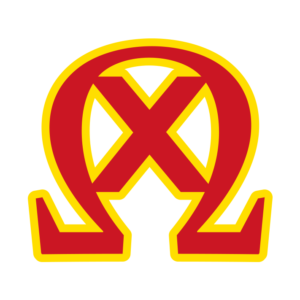 , you’ll announce that you have an Echo pile.)
, you’ll announce that you have an Echo pile.) - Once announced, each out-of-game pile either becomes Public or remains Private. If it becomes public, each other player can now look through it any time. If it remains private, only the player who owns the pile can look through it. However, all players get to know how many cards are in it. (Example: At the start of the game when you announce that you have a Sinister Six pile, it becomes public and the other players can now look at it. On the other hand, Ahab’s Hound pile remains private even after you put your first Hound into your hand. But your opponent can always know how many Hounds are left in the pile.)
- You own each pile that goes with your deck. You can only access cards in a pile you own, and you can only access it via the printed game text from a card you own. This means:
- You can’t access a pile owned by another player. (Example: If you take control of another player’s Mattie Franklin you won’t be able to access that player’s Gift pile.)
- You can’t access one of your own piles via a card you don’t own. (Example: You take control of another player’s Inventor. You can’t use them to access your own Invention pile.)
- You can’t access one of your own piles via a copied power. (Example: Your Hyperstorm copies your Mystique’s Level 3’s Identity Theft Hyperstorm can’t access Mystique’s Transformation pile because only a printed power can access a pile.)
- Cards in your Out-of-Game piles do not affect deck-building rules such as Loyalty (including general Loyalty, team-specific Loyalty, and Good/Evil Loyalty).
- Some Formats may have restrictions on what can be included in Out-of-Game piles. In this case, if a card requires a pile, and you can’t make a legal pile for that format, then that card is illegal as well.
Several cards have been updated to use out-of-game piles including but not limited to:
(Note: This change doesn’t affect how they play.)
- Bruce Banner (main character) now uses and I’m Always Angry pile.
- Fin Fang Foom Boss Battle card now uses a Fin Fang Foom pile.
- Hawkeye (main character) now uses a Quiver pile.
- Professor X (main character Level 3) now uses a Graduation pile.
- Superior Spider-Man now uses a Friendly Neighbor pile
- Winter Soldier (MCU, main character) now uses a The Man on the Bridge pile.
Example: If your main character is Bucky Barnes, you’ll start the game with Bucky Barnes (Level 1) on your side. Winter Soldier (Level 2) will start in your Level Up Zone because Bucky’s Level 1 text says as he levels up, he transforms into Winter Soldier. Finally, you’ll also have an out-of-game The Man on the Bridge pile Bucky Barnes (Level 2) in it.
Bucky Barnes (Level 2) does not start in your Level Up Zone because neither Bucky (Level 1) or Winter Soldier level up into him.
When Winter Soldier transforms into Bucky (Level 2) you’ll put Bucky onto your side and Winter Soldier back into your Level Up Zone. If Bucky (Level 2) transforms back, you’ll put him back into your The Man on the Bridge pile and put Winter Soldier back onto your side.
You may be wondering why it matters whether Bucky Barnes (level 2) uses out-of-game piles or just went into the Level Up Zone. In this case, it doesn’t really matter (which is why the question of where exactly the card goes has not come up before). The reason we’re defining things this way now is to tighten up the overall rules of the Level Up Zone and Out-of-Game piles, especially with regards to looking ahead to potential future cards.
Finally, the Invention pile has been given a functional update. When first printed, its content was Fixed. Now it is Variable: all Inventions you choose to include are now optional. For example, you no longer have to include any of the neutral Inventions.
Token Cards
Some cards generate tokens. Unless otherwise stated, these cards do not use piles or the piles rules. (Example: You can’t access any of an opponent’s piles. However, if you take control of an opponent’s Goblin Queen, you CAN use her super power to make Demon Goblin tokens because Goblin Queen doesn’t use a pile.)
List of Out-of-Game Piles
The full list of Out-of-Game piles can be found on upperdeck.com/op/
Leveling Up Characters
We’ve tightened up and updated the rules for how Leveling Up works, especially for characters that have the same name (including through AKA).
The main addition is that (unless otherwise stated on the card) a card must share a team affiliation with the card it levels up into. (See #3 below.)
These updates will not affect which cards can Level Up into which cards. All cards will continue to play as they have before.
Here are the updated rules which determine which cards can level up into which other cards. (Updates are underlined.)
If a main character has a Level Up power, it can level up into another main character that is one level higher if ALL of the following criteria are met:
- NAME: The two cards must have the same name (including AKA).
- LINK: The two cards must be linked either by:
- Being in the same set -OR-
- By having the same art -OR-
- By one of them having the same art as a character the other one is already linked to. (Example: Thanos Level 1 from the MCU Villains set can level up into the Thanos Level 2 from the Space and Time set.)
- TEAM: If the cards have any team affiliations, they must share at least one of them (unless otherwise stated on a card).
We’ve added #3 “TEAM” above to avoid situations where two characters share a name (sometimes including AKA) but are not meant to level up into each other.
Example: There are two different Spider-Man main characters in the Civil War Battles Issue: one on the Pro-Registration team and one on the Anti-Registration team. A Level 1 Spider-Man from one of those teams cannot level up into a Level 2 Spider-Man from the other team.
As always, cards can have game text that supersede the rules and allow a card to level up into another card even if the above criteria aren’t met. Here are some examples:
Example 1: Logan (Level 4) explicitly says that Wolverine (Level 3) can level up into him, even though they don’t share a name.
Example 2: Bucky Barnes (MCU Heroes, Level 1) says as he levels up he transforms into Winter Soldier (MCU Villains, Level 2).
Example 3: Emma Frost (X-Men, Level 1) says she levels up into either Emma Frost (H.A.M.M.E.R., Level 2) or Emma Frost (Mutant Resistance, Level 2)
Note: Three existing main characters currently change team affiliations when they level up which means they fail the “TEAM” requirement listed above. These cards will be given wording updates that allow them to ignore that requirement. (See Mysterio, Quicksilver, and Scarlet Witch in “Under the Hood” Updates to Specific Cards.)
Transforming Characters
This section is going to clarify how transformations work. The idea of transformation is that one character becomes another character. Therefore any aspects of the old character (counters, equipment, modifiers, etc) are transferred to the new character. This is very similar to how a main character leveling up works.
Here are the full details:
- When a character transforms into another character, put the new card into play in the same place where the old card was (same row, next to the same other characters) and with the same orientation (ready/exhausted; face up/face down).
- This does NOT count as the new card “appearing.”
- Put any counters or equipment that were on the old card onto the new card.
- This does NOT count as the new card gaining counters or equipment.
- If any modifiers (such as Freeze) were affecting the old card they are now affecting the new card.
- If the old card was a supporting character, remove it from the game.
- If the old card was a main character that either started the game on your side or in your Level Up Zone, put it into your Level Up Zone.
- If the old card was a main character that started the game in a pile, put it back into that pile.
Main Character Cards Entering the KO pile
This is an update and simplification of what happens when a main character card gets put into a KO pile.
If a main character card is put into a KO pile for any reason it gets removed from the game.
This includes when a main character gets KO’d as well as any situation where a main character card goes from your hand, deck, or some other zone into the KO pile. It also includes cases where a non-Main Character card that has somehow been made into a main character gets KO’d.
Example 1: You have some extra main characters on your side that started the game in an out-of-game pile because of Professor X’s Graduation. When one is KO’d, it gets removed from the game.
Example 2: An effect puts several cards from your deck into your KO pile. Some of these cards are main characters with Spider-Verse. They are removed from the game.
Example 3: Kingpin (supporting character) has used Underworld Boss to become your main character. When he gets KO’d, he’s removed from the game.
As always, card effects can override these rules.
Example: When Spider-Ham gets KO’d, his Cartoonish Immortality will let you shuffle him into your deck.
Equipment Powers
Up until now the rules for Equipment were that “The powers on the equipment are granted to the character it’s attached to.” Over time some equipment have been designed that include powers that don’t make sense or are problematic to be granted to the character.
A few examples are:
- Unique (Example: Soulsword)
- Standard Issue (Example: Hydra Assault Rifle)
- Unwanted Gift (Example: Serpent Crown)
With today’s update we are redefining how powers on equipment work:
- Powers on an equipment belong to that equipment. If the equipment grants an effect to the equipped character it will say so. (This is already the way equipment cards are written. For example: “Equipped character has +2/+2.”)
- If an equipment has a super power, only the equipped character can pay to use that super power.
If an equipment refers to “you” or “your” it means the player with the equipped character on their side. Similarly, if an equipment refers to “enemy characters” or “enemy players”, this refers to enemy sides from the equipped character’s perspective.
This update will affect Equipment gameplay in a few ways. The most impactful result is:
If the equipped character loses its powers, this will NOT remove any powers from the equipment.
For example, if an equipment is granting +2/+2 to the equipped character, an effect that causes that character to lose its powers will not remove the +2/+2 since that comes from the equipment’s power.
Note: If the equipment is granting a power (like Ferocious or ![]() ) to the character, then that power will be lost if an effect causes the character to lose its powers.
) to the character, then that power will be lost if an effect causes the character to lose its powers.
Another example is The Nullifier’s Ultimate Nullification power which reads:
When The Nullifier appears, name a keyword or super power.
Enemy characters lose and can’t gain that power until The Nullifier leaves play.
Since under the new rules this power is no longer granted to the equipped character, causing that character to lose its powers will not turn off Ultimate Nullification.
Some effects refer to a character’s super powers with wordings like “its super powers” or “their super powers.” In these cases, this refers only to super powers the character has, not super powers it can access from equipment equipped to it. (In other words, the super power still belongs to the equipment even though the character is allowed to use it.)
If an equipment is the source of a character getting stunned (for example, an equipment that has an effect that reduces a character to 0 DEF), the equipped character will also count as the source of that stun.
Card Names and Intellectual Properties
The Vs. System 2PCG includes characters from many different Properties. Some cards have the same card titles as cards in other Properties. In these cases those cards do NOT count as the same name for the purposes of uniqueness or power ups.
On the other hand, if an effect requires you to “name a card” and you choose a name that occurs in multiple Properties, it will count all of those cards.
Functional Updates to Specific Cards
The following update will affect how this card plays (What’s different is underlined.)
*Bishop*
LEG-015, Supporting Character, X-Men
This supporting character’s name is being updated to:
Bishop (no stars)
Gamora (Level 2)
MNB-058, Main Character, Guardians of the Galaxy
Godslayer Blade
Main ![]()
![]() : This turn, when Gamora stuns a character by striking it in combat, KO it.
: This turn, when Gamora stuns a character by striking it in combat, KO it.
Explanation: This change is to avoid Gamora using an out-of-combat stun (including a daze) to KO a main character.
COPYING POWERS
The following cards are able to copy powers. They are all being updated to only copy “printed” powers. (Changes are underlined.)
Explanation: This change avoids weird or otherwise undesirable interactions when a character is copying the powers of a character that currently has non-printed powers (such as powers granted from equipment or plot twists).
Hope Summers
MNB-037, Supporting Character, X-Men
Hope has all the printed powers of each other ![]() supporting character on your side.
supporting character on your side.
Onslaught
LEG-035, Supporting Character, Supervillains
When you recruit Onslaught, each player reveals cards from the top of their deck until they reveal a character other than Onslaught. Remove those characters from the game and shuffle the remaining cards into those decks. Onslaught has the printed powers of the removed cards and base stats equal to their total printed ATK, total printed DEF, and total printed ![]() .
.
Prowler
SPF-015, Supporting Character, Spider-Friends
Once per turn, during your Build Phase, you may discard a supporting character. If you do, Prowler has that character’s printed Main and Combat super powers this turn.
Super-Skrull (Level 2)
FAN-036, Main Character, Frightful
When Super-Skrull levels up, he gains the printed keyword and super powers he doesn’t already have from the following face-up characters: Human Torch, Invisible Woman, Mister Fantastic, and the Thing.
When Human Torch, Invisible Woman, Mister Fantastic, or the Thing appears, Super-Skrull gains the printed keyword and super powers he doesn’t already have from them.
“Under the Hood” Updates to Specific Cards
These updates will make sure the following cards work within the most recent rules. It will not change their functionality. (Changes are underlined.)
Mysterio (Level 1)
MCU7-001, Main Character, MCU Heroes
There’s Only One Left
Level Up (1) – When an enemy Hologram is KO’d, Mysterio gains an XP. Mysterio Levels up into ![]() Mysterio Level 2.
Mysterio Level 2.
Explanation: Mysterio starts off with the MCU Hero team affiliation and at Level 2 switches to MCU Villain. The updated text allows Mysterio to level up correctly under the new Level Up Rules above.
Quicksilver (Level 1)
MCU5-010, Main Character, MCU Villains
Who Decides Who’s Weak?
Level Up (4) – When a supporting character attacks a supporting character with a lower cost, Quicksilver gains an XP. Quicksilver Levels up into ![]() Quicksilver Level 2.
Quicksilver Level 2.
Scarlet Witch (Level 1)
MCU5-012, Main Character, MCU Villains
Terrible Loss
Level Up (3) – When another character on your side gets stunned on an enemy player’s turn, Scarlet Witch gains an XP. Scarlet Witch Levels up into ![]() Scarlet Witch Level 2.
Scarlet Witch Level 2.
Explanation: Quicksilver and Scarlet Witch each start the game with the MCU Villain team affiliation at Level 1 and at Level 2 switch to MCU Hero. Their updated text allows them to level up correctly under the new Level Up Rules above.
Mister Fantastic (Level 1)
FAN-005, Main Character, Fantastic Four
First Family (Updated Wording)
Level Up (3) – When each of the following characters appears on your side for the first time while Mister Fantastic is face up, Mister Fantastic gains an XP: Invisible Woman, Human Torch, and the Thing.
Explanation: This fixes a strange case where (for example) Invisible Woman appears for the first time on your side while Mister Fantastic is face down. This would mean he wouldn’t gain an XP at that time, and would never be able to gain an XP from her since she could never appear “for the first time” again.
Kang
FRI-009, Supporting Character, Frightful
The Tomorrow War (Updated wording)
During setup, right before players draw their opening hands, secretly choose a Future Date. Kang can’t appear unless it is that Date.
Explanation: This clarifies that The Tomorrow War’s effect takes place during setup before the game actually starts.







